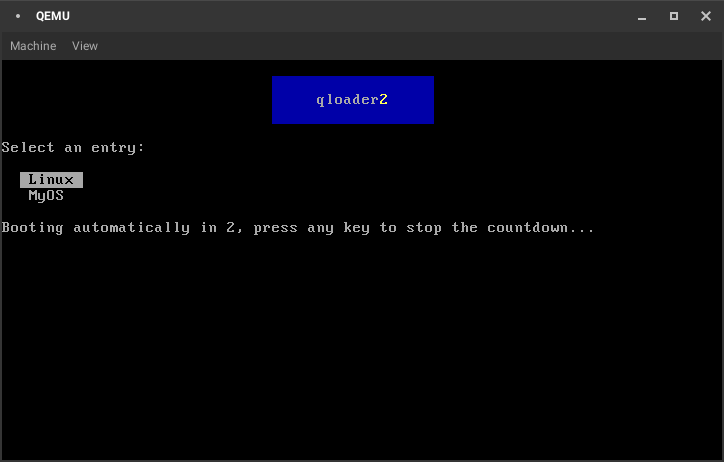* Mark the partition as bootable Some BIOSes (eg. my laptop's) require at least one partition to be marked as bootable, this patch can save one from frustration. * change loader.img to test.img i made a mistake Co-authored-by: Visual <30368284+VisualDevelopment@users.noreply.github.com> * additional comment Co-authored-by: Visual <30368284+VisualDevelopment@users.noreply.github.com> Co-authored-by: Visual <30368284+VisualDevelopment@users.noreply.github.com>
2.6 KiB
qloader2
x86/x86_64 BIOS Bootloader
Supported boot protocols
- Linux
- stivale (qloader2's native boot protocol, see STIVALE.md for details)
- TempleOS
Supported filesystems
- ext2
- echfs
- FAT32
Supported partitioning schemes
- MBR
- GPT
How to use
This repository contains a prebuilt version of qloader2 so building it won't be necessary.
In order to install qloader2 on a MBR device (which can just be a raw image file),
run the provided qloader2-install script as such:
./qloader2-install ./qloader2.bin <path to device/image>
If using a GPT formatted device, it will be necessary to create an extra partition (of at least 32K in size) to store stage 2 code. Then it will be necessary to tell the install script where this partition is located by specifying the start sector.
fdisk <device> # Create bootloader partition using your favourite method
./qloader2-install ./qloader2.bin <path to device/image> <start sector of boot partition>
Then make sure the device/image contains at least 1 partition formatted in
a supported filesystem containing a /qloader2.cfg or /boot/qloader2.cfg file
and the kernel/modules one wants to load.
An example qloader2.cfg file can be found in test/qloader2.cfg.
More info on the format of qloader2.cfg can be found in CONFIG.md.
For example, to create an empty image file of 64MiB in size, 1 echfs partition on the image spanning the whole device, format it, copy the relevant files over, and install qloader2, one can do:
dd if=/dev/zero bs=1M count=0 seek=64 of=test.img
parted -s test.img mklabel msdos
parted -s test.img mkpart primary 1 100%
parted -s test.img set 1 boot on # Workaround for buggy BIOSes
echfs-utils -m -p0 test.img quick-format 32768
echfs-utils -m -p0 test.img import path/to/qloader2.cfg qloader2.cfg
echfs-utils -m -p0 test.img import path/to/kernel.elf kernel.elf
echfs-utils -m -p0 test.img import <path to file> <path in image>
...
./qloader2-install $THIS_REPO/qloader2.bin test.img
One can get echfs-utils by installing https://github.com/qword-os/echfs.
Building from source
In order to hack qloader2, one must build the GCC toolchain from source first.
To do so, run the make_toolchain.sh script from within the toolchain directory;
keep in mind that the script takes MAKEFLAGS as an argument.
cd toolchain
./make_toolchain.sh -j4
After that is done, simply run make in the root of the repo to generate
src/qloader2.bin.
Discord server
We have a Discord server if you need support, info, or you just want to hang out: https://discord.gg/QEeZMz4
